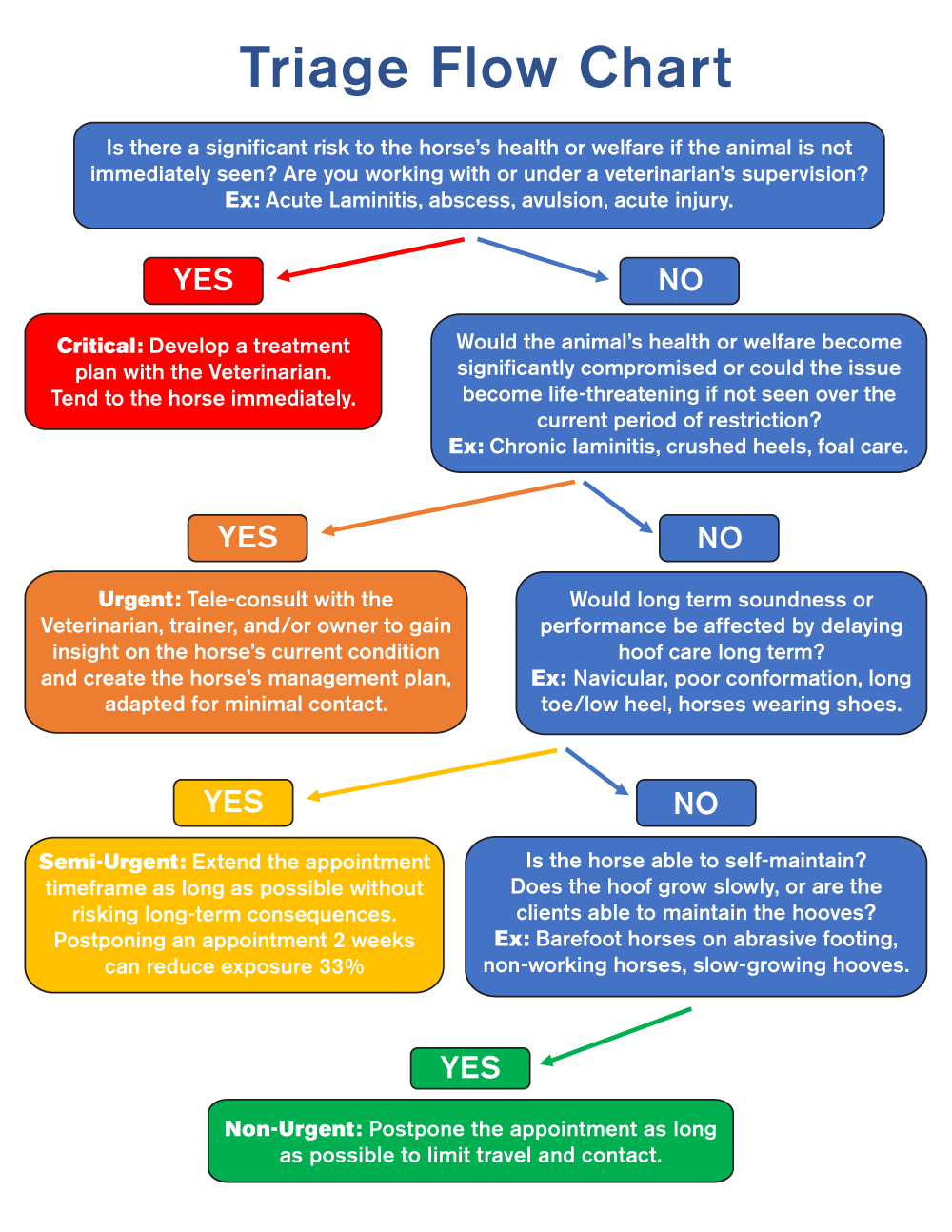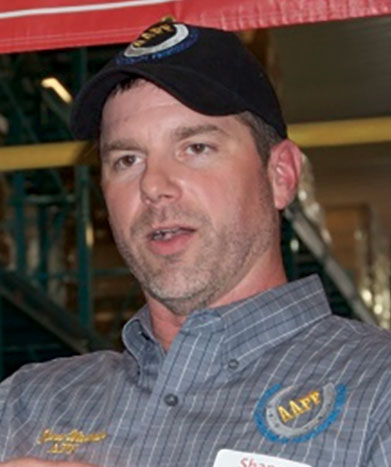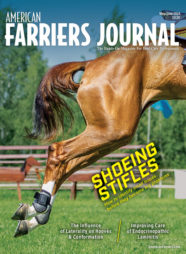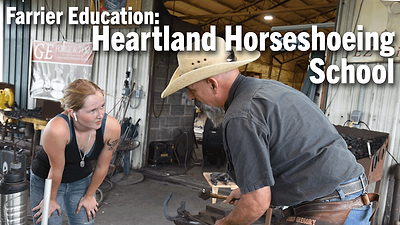During an infectious disease outbreak, such as the current outbreak of COVID-19, small business owners must prepare for disruption in their normal business practices as well as prepare to protect their community’s safety and health. Farriers, as well as veterinarians, have almost universally been recognized as essential services – still allowed to travel and continue to provide their services – but this does not mean it is business as usual.
According to the Centers for Disease Control and Prevention, “Coronavirus disease 2019 (COVID-19) is a respiratory illness that can spread from person to person. It spreads between people who are in close contact with one another (within about 6 feet) and through respiratory droplets produced when an infected person coughs or sneezes…It may be possible that a person can get COVID-19 by touching a surface or object that has the virus on it and then touching their own mouth, nose, or possibly their eyes.”
Implementing safety practices, such as using a routine disinfection protocol and minimizing person-to-person contact in the work environment, will help defend against spread of the disease and protect the health of the practitioner, the client, and the community.
Dr. Helen Aceto, B.Sc., Ph.D., V.M.D, Associate Professor of Veterinary Epidemiology, Director of Biosecurity at the University of Pennsylvania School of Veterinary Medicine (Penn Vet)’s New Bolton Center says, “It is critical that the farrier and anyone else present during an appointment wear masks – even those who do not presently have symptoms associated with COVID-19. Even alternative options, such as textile/cloth masks, are better than nothing and do cut down on the transmission of aerosols.” While a 6-foot social distance reduces risk significantly if you're just passing someone in the street, the risk of exposure increases with prolonged contact. According to Aceto, “Even though larger heavier droplets (> .0002 inches or 5 microns in size) fall to the ground within 6 feet of an infected person, it is now known that smaller droplets can travel much further; if propelled by a vigorous sneeze or cough, smaller droplets can travel far as 30 feet. Additionally, breathing and speaking creates aerosols that can spread the virus.”
The following are some recommended biosecurity best practices specific to farrier services that can be implemented and shared.
Before the Appointment
Employees, assistants, helpers, and apprentices
- Wear masks. The farrier, assistants, and everyone with whom they come in contact should wear masks. Carry new masks in separate paper bags to supply to clients that might not have one.
- Minimize travel and contact with other people. Limit close-quarter contact (such as riding in the same vehicle) to as few people as possible.
- Pre-screen. Employers should be aware of the employee’s temperature and any symptoms prior to the employee starting work. Ideally, temperature checks (temperature should be under 100 degrees F) should happen before the individual enters the workspace. Symptoms of COVID-19 are variable enough (respiratory, GI, chills) that employees with any signs of disease should not come to work.
- Regular monitoring. As long as the employee doesn’t have a fever or symptoms, they should continue to self-monitor under the supervision of their employer.
- Social distance. The employee should maintain 6 feet distance from the farrier and practice physical distancing from every other person as work duties permit.
- If the employee becomes sick during the day, they should be sent home immediately and all common workspaces and tools disinfected.
- If you work alone, message someone reliable regularly to tell them you are "safe." Have another person on site visually check every half hour for safety.
Use contactless communication for consultation and planning
- Use electronic media to share radiographs, pictures or video with a veterinarian or other equine professionals while consulting on a case.
- Use electronic media to consult or answer client questions about a case or other concern. Have the client send pictures, or video conference, rather than arranging an in-person consultation.
- Call, text or email the primary contact, understand the needs of the horse, and work up a hoof-care plan for the appointment before you arrive at the barn.
- Inform the barn manager/client of your biosecurity plan and ask about biosecurity measures they have in place.
- Establish whether any person at the facility has been exposed to COVID-19 or has shown any symptoms of the disease.
- Schedule visits to large boarding barns at a time when fewer people are present and staff are less busy.
- Notify the primary contact of the limitation that only one person can be present at the appointment.
Triage caseload
The goal of triaging your caseload is to assign a level of urgency to each client, ask which cases can be postponed and for how long. The goal of this process is to minimize travel and close contact with each other, recognizing that almost all cases will become emergent in time without maintenance.
Critical – If not attended to, would have a direct negative impact on the horse’s health, soundness, or welfare. Appointment should be kept. Acute injuries, laminitis, or abscess may be critical.
Urgent – Timing of the hoof care appointment may be an important factor in maintaining soundness but is not immediately critical. Try to postpone the appointment. A one-week delay on a six-week schedule is about a 17% reduction in exposure. Chronic pathology, navicular disease, or white line disease may be urgent.
Semi-Urgent – Timing of the hoof care appointment is a less significant factor in maintaining immediate soundness but may be a factor in the long term. Postpone the appointment 1-2 weeks. A two-week extension on a six-week schedule is a 33% reduction in exposure. Poor conformation, or horses wearing shoes, regularly exercised, or with maximum hoof growth rate may be semi-urgent.
Non-Urgent – The hoof care schedule can easily be extended without any long-term effect on health or welfare. Postpone the appointment 2-4 weeks. Slow growing hoof, barefoot, or non-working horses may be non-urgent.
During the Appointment
Personal Protective Equipment (PPE)
- Wear a mask that covers both your nose and mouth. Try not to touch or adjust the mask once it is in place. Change masks between facilities. Textile/cloth face coverings should:
- fit snugly but comfortably against the side of the face
- be secured with ties or ear loops
- include multiple layers of fabric
- allow for breathing without restriction
- be able to be laundered and machine-dried without damage or change to shape
- Consider wearing gloves while handling horses and equipment in high risk facilities. Change gloves between each horse. Do not touch your face/mouth/nose/eyes.
- Wash hands continuously for 20 seconds and/or use hand sanitizer frequently
- Consider wearing coveralls over clothes so that coveralls can be removed before leaving the premises and placed in a bag for laundering. If not possible, consider changing clothes between facilities.
While working
- Try to maintain at least a 6-foot distance from other people, and have the handler stand on the opposite side of the horse from the farrier (if possible).
- Limit attendance to one person in the workspace in addition to the farrier. Additional people may attend on speakerphone or video call.
- If the horse is to be tied, have the horse’s handler tie the horse. Avoid touching the horse’s tack.
- To avoid contamination, use your own halter/lead rope/chain/longe line if you catch the horse.
- Avoid touching anything besides your own tools. Avoid gate latches, door latches, shovels, brooms, wheelbarrows, etc. if possible.
- Wash hands continuously for 20 seconds or use hand sanitizer frequently while at the facility
After the visit
- Restrict the use of paper checks, appointment reminders, and pens.
- Use electronic forms, documentation and payment processing.
- Disinfect credit cards and wash hands after use.
- Wash your hands well after touching cash payments.
- Equipment and supplies should be cleaned and disinfected after each facility.
- The cell phone, steering wheel, gas cap, knobs, gear shifter, keys, seat, farrier box handles, toolbox, tools, and door handles are frequently contacted surfaces, thus require frequent disinfection with approved disinfectants.
- Leather goods, such as the farrier apron and boots, should be cleaned. Little information is currently available, but basic soap and a 70% alcohol solution is suggested. Condition leather after cleaning to protect products.
- Although there is no evidence that horses can contract or become ill from COVID-19, practice good hygiene by washing your hands with soap and water for a minimum of 20 seconds or using a 60 -70% alcohol hand sanitizer after touching a horse, communal areas, or communal equipment to prevent environmental spread of the virus. Definitely wash or sanitize hands before getting in your vehicle to leave the facility. Hand sanitizer is not as effective as soap and water, so only use this when there is no soap and water available and hands are not visibly soiled.
- Provide your own refreshments and food. Politely decline offerings from clients.
- Thank the clients graciously for following your biosecurity protocols.
Traveling
- Plan bathroom stops to avoid public facilities such as gas stations. Use your home or a less-occupied barn.
- Disinfect gas pump handle prior to filling up, and hands after using.
- Sanitize your credit card after use in public spaces.
- Remove work clothes and footwear and shower immediately upon arrival to home. Wash work clothes daily.
References and Resources
- American Association of Equine Practitioners
- American Veterinary Medical Association
- Northern California Association of Equine Practitioners
- Pennsylvania Veterinary Medical Association
- American Horse Council
- Farriers Registration Council
- British Farrier’s and Blacksmith’s Association
- Centers for Disease Control and Prevention
- United States Environmental Protection Agency
- Nerdwallet Estate Planning Basics
- NOLO









Post a comment
Report Abusive Comment